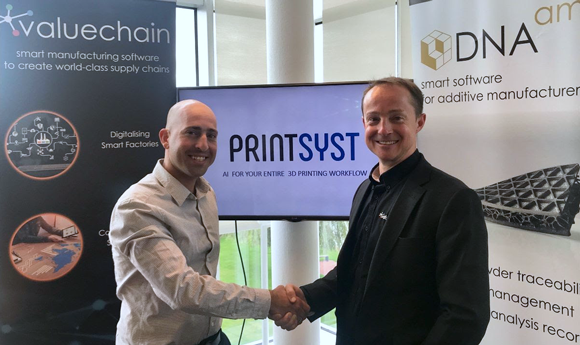Valuechain’s DNA.am MES adds PrintSyst’s AI engine to optimise AM production
December 3, 2020

DNA.am Ltd, a Valuechain Enterprise Systems business located in Daresbury, UK, and Printsyst, Rishon LeZion, Israel, have completed the integration of PrintSyst’s AI engine, the 3DP AI-Perfecter™, into Valuechain’s industrial-grade MES, DNA.am.
The two companies formed a partnership in 2019 to develop an integrated MES capable of leveraging PrintSyst’s AI engine, which enables an automated pre-build workflow and thus assists customers in industries such as aerospace, automotive, and defence to significantly improve their productivity and scale up their AM production.
According to the companies, the integrated Valuechain-PrintSyst solution provides state-of-the-art smart automation that learns from previous Additive Manufacturing builds and analyses the intent for which a specific part is going to be used to comply with industry specifications. It then suggests AM parameters that will have the highest probability of right-first-time builds, accurately estimates AM parts costs, recommends the most suitable materials to be used based on AM parts’ functional needs and eliminates the need for trial and error.
“Industrial 3D printing has continued to grow over recent months, as companies that initially trialled the technology are looking to scale up,” stated Tom Dawes, CEO of Valuechain. “Covid-19 has illustrated the importance of a robust supply chain structure, underpinned by secure collaboration and intelligence. However, many of these companies lack the digital solutions that drive 3D printing productivity while providing a path for an automated, standardised and certifiable digital workflow. Based on our customers’ feedback so far, I am confident that our collaboration with PrintSyst will be pivotal in addressing this critical need.”
Itamar Yona, PrintSyst’s CEO and co-founder, added, “Combining our world-class AI engine and hands-on industry experience, with DNA.am’s leading industrial-grade MES, will step change the manual, costly and unscalable 3D printing workflow. We are now able to take into account multiple additional parameters that exist in DNA.am MES and automatically train our engine so we can provide instant, highly personalised and optimised printing recommendations to our joint customers.”
















